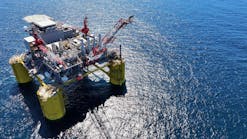Oman Oil Co. has changed the route of its planned Oman-India gas pipeline.
The change stems from a seabed survey that shows part of the original intended path is too rugged for pipelaying.
In another move aimed at sending more Omani gas to market, shareholders of Oman LNG LLC Co. approved the budget to establish a liquefied natural gas project.
Budget approval clears the way for project specification to begin later this year. Specification is likely to take a year, an Oman LNG official said.
PIPELINE ROUTE
Racal Survey Ltd., New Malden, U.K., in April began to study a 5 km wide corridor along the original gas pipeline route from Sur, Oman, to India's West Coast.
The survey revealed a barrier of rough terrain off the Omani coast, where faulted upthrusts created abrupt changes of relief. Racal then searched south along the Omani coast for an easier path.
The survey team identified a new route outward from Ra's al Jifan for 150 miles to the Omani Scarp. At the scarp, the new route heads east along the abyssal plain of the Omani Basin, where water depth is 3,500 m.
The new route meets the original route south of the Owen fracture zone at the southern end of Pakistan's 200 mile territorial limit. From there, the new route essentially follows the original path to India.
Racal has completed a survey of the new proposed route. However, the monsoon season brought work to a halt. In September, Racal will begin core sampling, which is expected to take 2 months, to complete the survey.
"Early results of a high resolution study of a I km wide corridor have not revealed anything to suggest that further route changes will be necessary," Racal said.
The original survey was expected to require collection of 1,700 line km of data. The need to find a different route meant 5,600 line km were acquired in total.
"However," Racal said, "in addition to being a technically easier prospect, the revised route is 20 km shorter than the original. At an estimated cost of 52 million/km of pipe laid, this is a useful saving."
Oman Oil plans to lay a 24 in., 1,100 km long pipeline to create new outlets for Omani gas in India's potentially fast-growing electrical power generation market (OGJ, July 5, 1993, p. 22).
Racal said Oman Oil is confident the pipeline construction schedule Will not need to be altered. Design packages are expected to be ready by the end of the year for construction companies invited to bid for the work.
A construction contract is scheduled to be awarded by mid-1995 to allow field work to begin in mid-1997. Gas delivery is slated for early 1999 at rates of as much as 2 bcfd.
LNG PROJECT
Construction of Oman's gas liquefaction plant is to begin in late 1996. Plant capacity will be 6 million metric tons/year.
Before capital investment is approved and work can begin, Oman LNG has to complete marketing arrangements. These should be final by yearend.
Oman LNG is negotiating for deliveries to start early in 2000. The company is said to be talking to potential customers in Japan, South Korea, Taiwan, Thailand, and Italy.
Oman LNG shareholders are the Oman government 51%, Shell International Petroleum Co. Ltd. 34%, Total 6%, Mitsubishi Corp. and Mitsui & Co. 3% each, Partex 2%, and Itochu 1%.
Copyright 1994 Oil & Gas Journal. All Rights Reserved.


